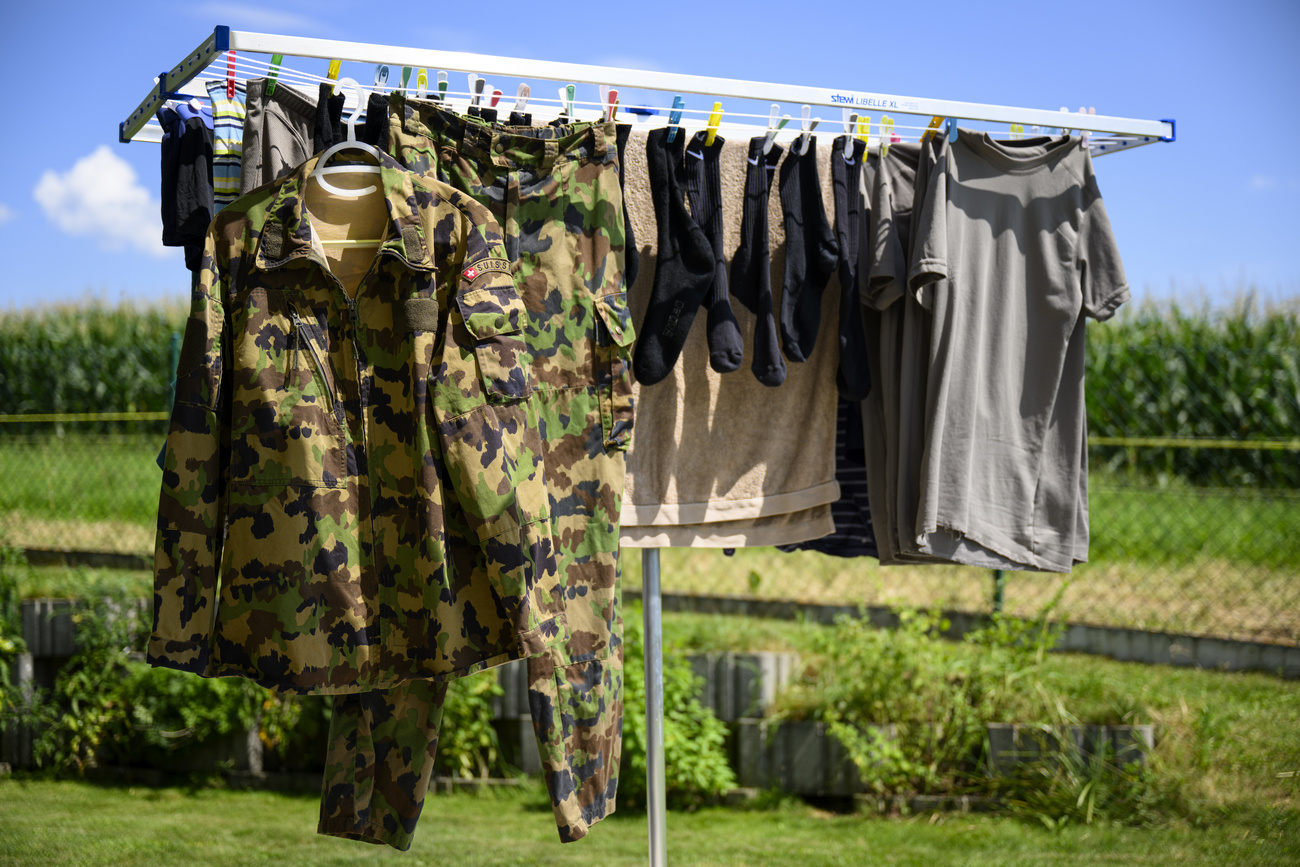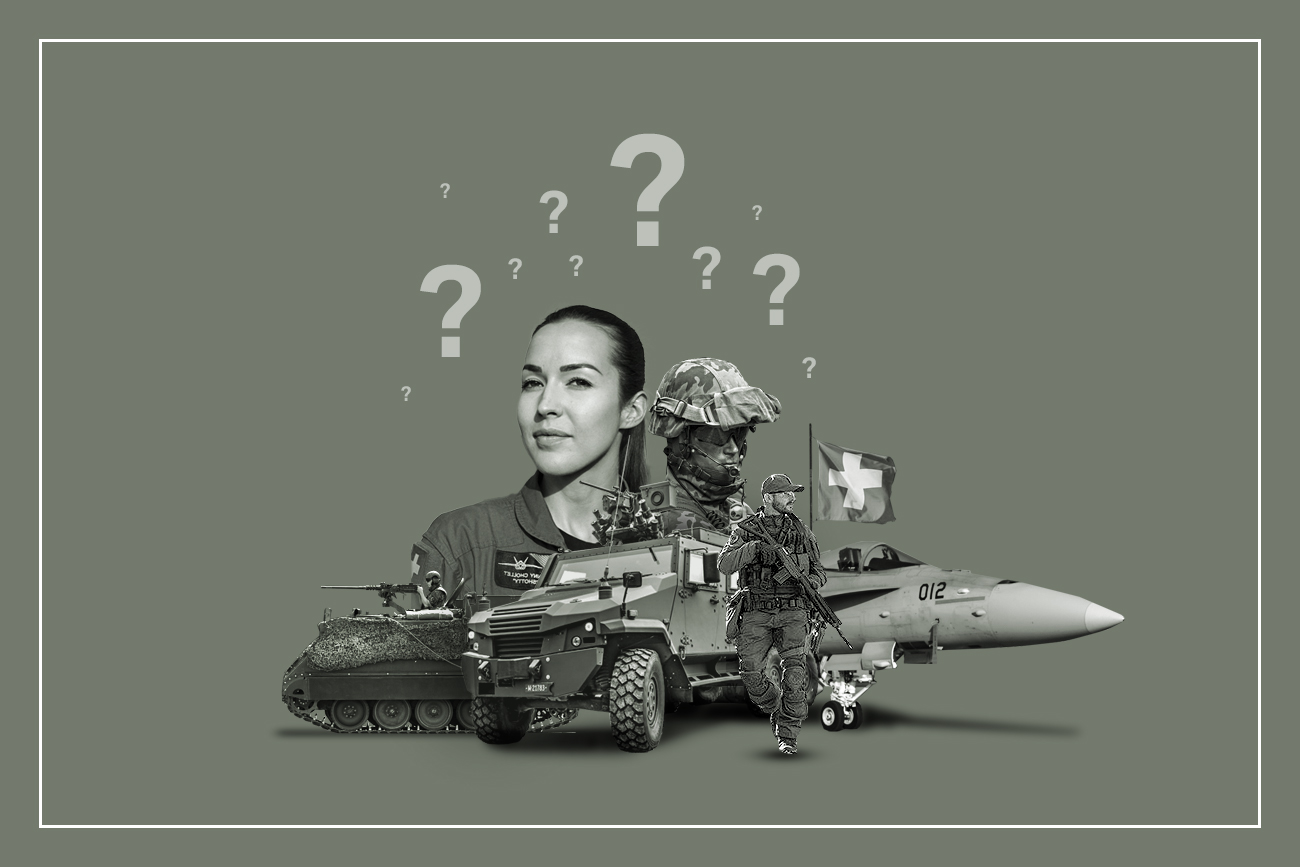Weapons or uniforms? The cost-cutting Swiss army has chosen

As in most Western countries, saving money is the order of the day for the Swiss authorities. This trend is even affecting the army, despite an overall budget increase. One casualty of this austerity is the dapper service uniform.
Tourists visiting Switzerland are sometimes surprised to see soldiers in camouflage on trains or in restaurants. This is likely to become even more frequent, as the Swiss army foresees a future almost exclusively in combat dress.
At the beginning of the year, it’s customary to make some good resolutions. For the Swiss army, this means saving money. On January 7, the Swiss Armed Forces said it had decided to stop issuing a service uniform – a smarter look which includes a blazer, shirt, belt, trousers and tie – to all troops.
“For reasons of economy, Swiss army service dress will henceforth only be issued for representational purposes,” it said in a statementExternal link. This uniform will be issued to around 1,500 people a year, compared with around 20,000 today. These “representational purposes” include military music and officer’s orders.

Produced in Asia and Eastern Europe, service uniforms cost around CHF330 ($362) each. Distributing them to all recruits costs around CHF5.2 million a year. “If they are issued only to those with representative duties, savings of CHF55 million could be made by 2035,” according to the statement.
The decision was implemented with immediate effect. No service uniforms were issued at the winter recruit school, which began earlier this week.
Service uniforms currently in soldiers’ possession must be returned by the end of their military service. They will either be stored for future use or destroyed.
Evolution of uniforms
In the old days, a single uniform was generally worn for all circumstances. But the use of weapons that fired ever further, faster and more accurately had a profound influence on the evolution of uniforms.
The first change was getting rid of shimmering, sparkling colours which made soldiers stand out like a sore thumb from miles away. Dodging enemy fire required being inconspicuous. Uniforms therefore became duller, coming in shades of grey-green, khaki, olive or horizon blue. The Swiss army switched from dark blue to grey-green during the First World War.
The Second World War brought about another change, with the increasing use of camouflage clothing to blend in with the surrounding terrain. The Swiss army adopted this new fashion with the first camouflage uniform in 1957.
Normally, the camouflage uniform is used for enlistment and active service itself, while the service uniform is used for periods of leave and discharge.

More
The Swiss army: your questions answered
Mixed reaction
In practice, however, the service uniform is being used less and less, particularly for exercises. The idea of doing away with the uniform had been in the air for some time, so the decision to do so at the beginning of January isn’t a total surprise.
Nevertheless, the decision is causing a stir in a country where a large proportion of the population – men at least – serve or have served in the armed forces. Opinions are mixed. In the media, several commentators have no regrets about the service uniform, which they describe as “ugly”, “badly cut” and “impractical”. Others, on the other hand, are more nostalgic tone and regret “penny-pinching”.
Army executives were equally divided. “I think it’s good news,” Guillaume Genoud, president of the Military Societies of Canton Geneva, told Swiss public radio, RTS. “It’s money that can be used for more urgent expenditure given the current threat. The uniform was being worn less and less. The average soldier will be happy to be free of it.”
In private discussions, however, the tone is sometimes also more critical. “It’s a pity,” says one infantry captain, “because a different uniform makes it immediately obvious whether a soldier is on leave or on duty.”
Cost-cutting measures
The army budget is increasing: in September parliament boosted it by CHF4 billion for the period 2025-2028, bringing the total to CHF29.8 billion. This will enable the military budget to reach 1% of GDP by 2030, rather than by 2035 as originally planned.
Despite these additional funds, the army wants to make savings. At the same time as abolishing service uniforms, it has announced savings of CHF210 million in personnel costs – without redundancies – by 2030. Also, in November, the Swiss Air Force announced it would be reducing the number of demonstrations and exhibitions in order to save money.

More
Swiss Air Force reduces displays to save money
A package of savings measures against a backdrop of rising budgets may seem strange. But this can be explained by the security situation in Europe. “The resources released will be allocated to equipping the armed forces, thereby strengthening defence capability,” the Armed Forces said in the statement.
The intention is laudable, but it remains to be seen whether the money is actually invested. Coincidentally, it was also at the beginning of January that an investigation by Swiss public television, SRF, revealed that new reconnaissance drones purchased in Israel and due to enter service in 2019 had been grounded due to a technical fault. Only four of the six ordered have been delivered, and they are not expected to be operational until 2029 at the earliest.
The purchase is worth CHF300 million, the equivalent of more than 900,000 uniforms.
Edited by Samuel Jaberg. Adapted from French by Thomas Stephens
More

In compliance with the JTI standards
More: SWI swissinfo.ch certified by the Journalism Trust Initiative










Join the conversation!